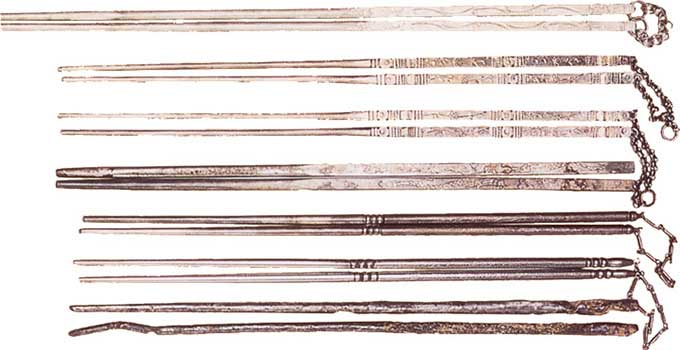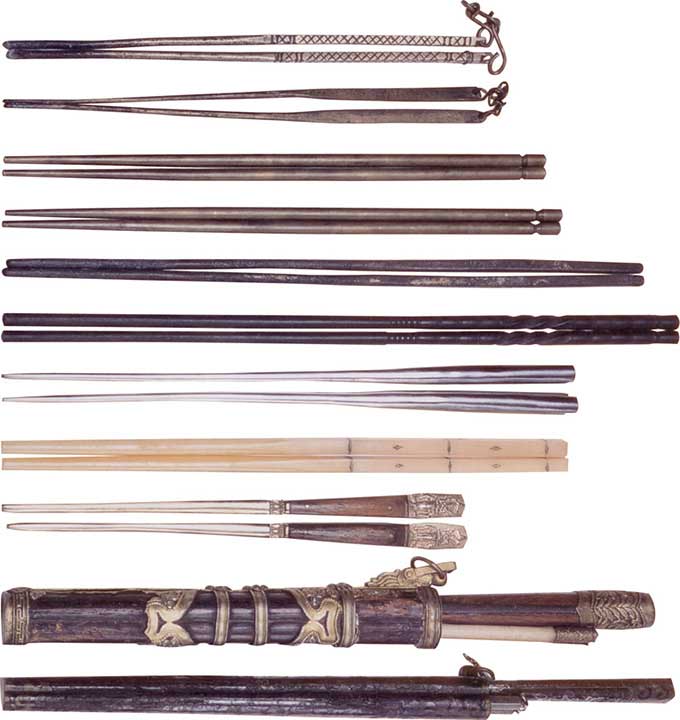Though people like to joke that a rice-staple country shouldn’t be eating with two long sticks, chopsticks lend themselves well to China‘s style of cuisine. Now ubiquitous in the country and in Chinese restaurants worldwide, they have a long and distinguished history. Here’s everything you need to know.
Chopsticks are one of the simplest, oldest and most widely used utensils for eating, and are still the primary eating utensil for over 22 percent of the world’s population today.

Ancient chopsticks from China
Chopsticks are kitchen/eating utensils that are shaped pairs of equal-length sticks that have been used in virtually all of East Asia for over two millennia. First invented and used by the Chinese during the Zhou Dynasty, chopsticks later spread to other countries of the East Asian cultural sphere.
In Southeast Asia, only Vietnam and ethnic Chinese communities consume all food with chopsticks. In Cambodia, Laos, Myanmar, and Indian and Malay communities in Singapore and Malaysia, as well as in Nepal, chopsticks are generally used only to consume noodles. In Thailand, chopsticks are now a part of their eating utensils along with the spoon and fork, where in the past chopsticks were never used.

Ancient silver chopsticks from China
Ancient chopsticks from China The first chopsticks came to Japan by way of Korea, around the area of Wakasa Bay on the Sea of Japan. This was a waypoint for travelers passing through between China and Kyoto and is considered the east end of the silk road and the front gate of Japan. Chopsticks in Japan were revered as precious and used in religious ceremonies. Their earliest chopsticks were joined at the top like tweezers. It wasn’t until 1,000 CE that separate sticks became the norm.
While chopsticks have been and are called by many different names in Asia, such as “kuai-zi” in China and “Hashi” in Japan, the English word chopsticks are likely derived from Chinese Pidgin English “chop-chop” meaning quickly. Therefore chopsticks mean “quick sticks”, perhaps an apt description given by the earliest western explorers as they first experienced people nimbly eating with chopsticks. The earliest written English use of the word “chopsticks” is from explorer William Dampier’s book Voyages and Descriptions published in 1699.

Additional ancient chopsticks from China
Wood and bamboo were the natural early forms of chopsticks, and are still the most common materials today. In time bone, ivory, bronze, brass, silver, gold, jade, agate, coral and other exotic materials have been used, especially for wealthy chopstick owners.
Ancient sets of chopsticks in China were commonly found with a knife and pouch, and chopsticks were frequently bound together at the handle end by a chain.
Silver chopsticks were popular with royalty as a measure of security. It was thought that silver would detect poison in food by turning black. Unfortunately for those who found out the hard way, silver has no reaction to cyanide or arsenic but does turn color in the presence of rotten eggs, onions, and garlic.
The Chinese chopsticks for restaurant have only one style of chopsticks with glod metal head and Chinese characters logo engraved on the chopsticks' body.They are made of environmentally friendly natural hard wood and metal,you can engraved your logo on the chopsticks' body. They are in the classic Chinese chopstick shape with a square profile handle and round profile tip.These Chinese chopsticks are 9-7/8 inches long. ..
These Chinese chopsticks have 5 styles of chopsticks with glod metal head and black chopsticks' body,fit for restaurants.They are made of eco-friendly pps material and metal.They are in the classic Chinese chopstick shape with a square profile handle and round profile tip.These Chinese chopsticks are 9-7/8 inches long. ..
These Chinese chopsticks have 4 styles of chopsticks with glod metal head and silver head,dishwasher safe,fit for restaurants.They are made of eco-friendly pps material and metal.They are in the classic Chinese chopstick shape with a square profile handle and round profile tip.These Chinese chopsticks are 9-7/8 inches long. ..
These Chinese chopsticks have 2 styles of chopsticks with glod metal head and silver head,dishwasher safe,fit for restaurants.They are made of eco-friendly pps material and metal.Chopsticks' body is in black color.They are in the classic Chinese chopstick shape with a square profile handle and round profile tip.These Chinese chopsticks are 9-7/8 inches long. ..
Longer than most other styles at about 27 centimeters, thicker, with squared or rounded sides and ending in either wide, blunt, flat tips or tapered pointed tips. Blunt tips are more common with plastic or melamine varieties whereas pointed tips are more common in wood and bamboo varieties. Chinese sticks may be composed of almost any material but the most common in modern-day restaurants is melamine plastic for its durability and ease of sanitation. The most common type of material in regular households is bamboo.
The couple Japanese chopsticks series have 2 styles of reusable chopsticks with printed solid colors pencil shape head for couples.These chopsticks are made of eco-friendly natural wood,handmade craftship.The chopsticks are lacquered in blue and brown colors,with thin tips...
The couple Japanese chopsticks series have 2 styles of reusable chopsticks with printed solid colors pencil shape head for couples.These chopsticks are made of eco-friendly natural wood,handmade craftship.The chopsticks are lacquered in black and brown colors,with thin tips...
The craft engraved Japanese chopsticks have 2 styles of reusable chopsticks with engraved binding wire patterns.These chopsticks are made of eco-friendly natural wood,handmade craftship.The chopsticks are lacquered in natural color,with thin tips...
The craft Japanese chopsticks have 3 styles of reusable chopsticks with special shape head.These chopsticks are made of eco-friendly natural wood,handmade craftship.The chopsticks are lacquered in natural color,with thin tips...
It is common for Japanese sticks to be of shorter length for women, and children’s chopsticks in smaller sizes are common. Many Japanese chopsticks have circumferential grooves at the eating end, which helps prevent food from slipping. Japanese chopsticks are typically sharp and pointed. They are traditionally made of wood or bamboo and are lacquered. Lacquered chopsticks were first used in the Yayoi Era, around 2000 years ago. Lacquered chopsticks are known in Japanese as Nuribashi, which has a number of varieties, depending on where they are made and what types of lacquers are used in glossing them. Japan is the only place where they are decorated with natural lacquer making them not just functional but highly attractive. The Japanese traditional lacquered chopsticks are produced from the city of Obama in Fukui Prefecture and come in many colors coated in natural lacquer and decorated with mother-of-pearl from abalone and with eggshell to impart a waterproof shield to the chopsticks extending their life.
Edo Kibashi chopsticks have been created by the hands of Tokyo craftspeople since the beginning of the Taishō Period (1912-1926) roughly 100 years ago. These chopsticks are combined with high-grade wood (ebony, red sandalwood, ironwood, Japanese box-trees, maple), which craftspeople plane by hand. Edo Kibashi chopsticks, which are pentagonal hexagonal or octagonal, make them easy to hold. The tips of them are rounded to prevent to damage the dish or the bowl.
In Japan, chopsticks for cooking are known as Ryoribashi, and Saibashi when used to transfer cooked food to the dishes it will be served in.